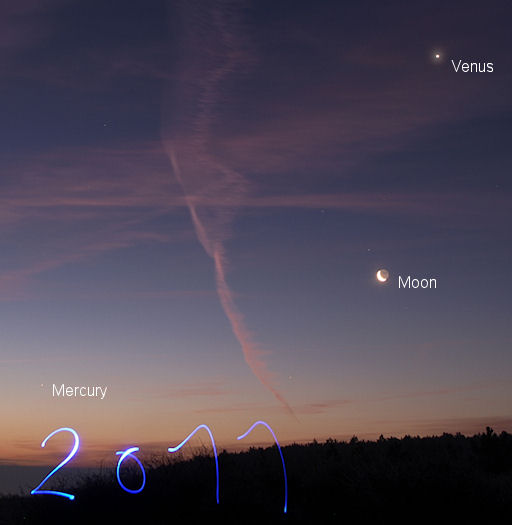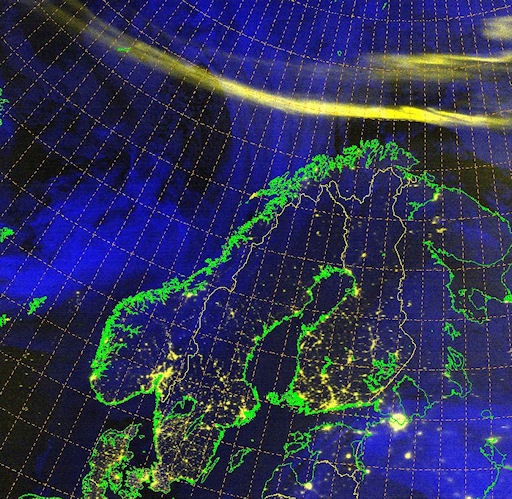Turn your cell phone into a field-tested satellite tracker. Works for Android and iPhone. | | | SUNSPOT ALERT: 2011 is beginning with a flurry of sunspots. Five dark cores have emerged on the Earth-side of the sun, giving readers with solar telescopes a quintet of targets for New Years Day. So far, none of the new regions is producing strong solar flares. sunspot images: from Cai-Uso Wohler of Bispingen, Germany; from Michael Buxton of Ocean Beach, California; from Gianfranco Meregalli of Milano Italy; from Howard Eskildsen of Ocala, Florida; DAWN OF A NEW YEAR: As 2010 wound down, Veszprem, Hungary, was enveloped in thick fog, "but the sky cleared for the first dawn of 2011," reports photographer Monika Landy-Gyebnar. "Some people were just returning home (with not too straight steps) from New Year's Eve parties as I went outside for a photo-shoot. The beautiful crescent Moon was just emerging from the fog-cloud, and Venus was almost as bright as Moon. Mercury was also there, just above the horizon." 
"This beautiful celestial scenery hovered above a landscape with hoarfrost on the bushes, which became pink as the dawn got closer. I used an LED lamp to write '2011' across one of the exposures. It was a wonderful beginning of a new year!" SINUOUS AURORAS: US Department of Defense polar-orbiting satellites are observing bright bands of auroral light circling the North Pole. This display, recorded on Dec. 30th, was as bright as the city lights of Scandinavia below: 
Paul McCrone of the Fleet Numerical Meteorology and Oceanography Center in Monterey, CA, assembled the image using visual and infrared data from three satellites: DMSP F13, F17 and F18. "It shows the sinuous path of the energetic particles entering Earth's upper atmosphere," he says. These sinuous bands could descend south over Europe and parts of North America around Jan. 3rd when a solar wind stream is expected to hit Earth's magnetosphere. High-latitude sky watchers should be alert for auroras.
Lunar Eclipse Photo Gallery
[NASA: "Solstice Lunar Eclipse"] [astronomy alerts]
November 2010 Aurora Gallery
[previous Novembers: 2009, 2008, 2007, 2006, 2004, 2003, 2002, 2001, 2000] Potentially Hazardous Asteroids ( PHAs) are space rocks larger than approximately 100m that can come closer to Earth than 0.05 AU. None of the known PHAs is on a collision course with our planet, although astronomers are finding new ones all the time. On January 1, 2011 there were 1167 potentially hazardous asteroids. Notes: LD means "Lunar Distance." 1 LD = 384,401 km, the distance between Earth and the Moon. 1 LD also equals 0.00256 AU. MAG is the visual magnitude of the asteroid on the date of closest approach. | | The official U.S. government space weather bureau | | | The first place to look for information about sundogs, pillars, rainbows and related phenomena. | | | Researchers call it a "Hubble for the sun." SDO is the most advanced solar observatory ever. | | | 3D views of the sun from NASA's Solar and Terrestrial Relations Observatory | | | Realtime and archival images of the Sun from SOHO. | | | from the NOAA Space Environment Center | | | the underlying science of space weather | | 
